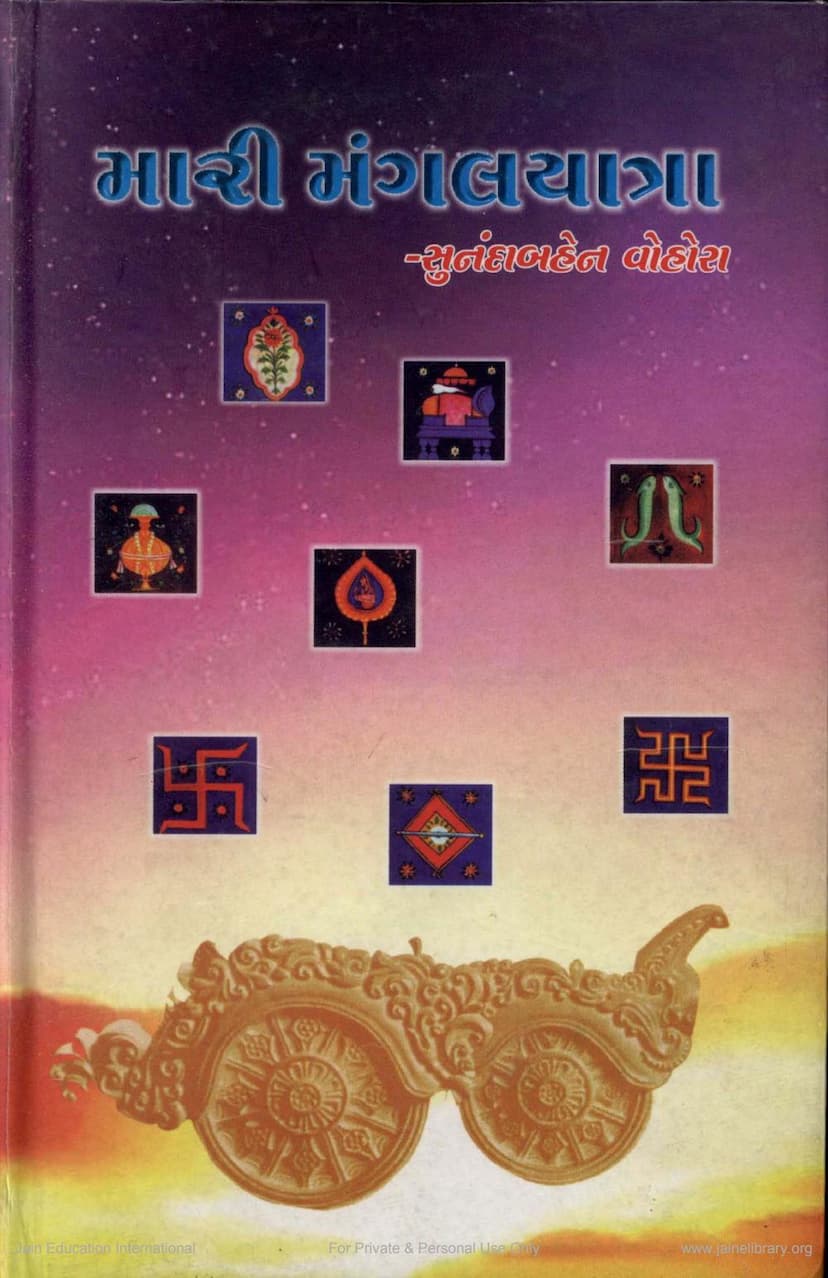Mari Mangalyatra
Added to library: September 2, 2025

Summary
Here's a comprehensive summary of the Jain text "Mari Mangalyatra" by Sunandaben Vohra, based on the provided pages:
Book Title: Mari Mangalyatra (My Auspicious Journey) Author: Sunandaben Vohra Publisher: Anandsumangal Parivar, America Publication Year: 2006
Overall Theme: "Mari Mangalyatra" is an autobiographical narrative by Sunandaben Vohra, detailing her life's journey from childhood through various significant phases, marked by spiritual growth, social service, personal challenges, and ultimately, a deep engagement with Jain philosophy. The title itself suggests a life considered auspicious, implying a path guided by spiritual principles and meaningful experiences.
Key Life Stages and Experiences:
- Early Life and Childhood: The book begins by touching upon her birth and early childhood, mentioning her parents, the loss of her mother at a young age, and her upbringing by her elder sister. It hints at a seemingly ordinary childhood with no extraordinary early events.
- Marriage and Family Life: At the age of fourteen, Sunandaben entered into married life. The narrative describes a happy and prosperous family life initially, filled with material comforts, a loving husband, and the joys of raising children. The text highlights the strong bond between her husband and his father, illustrating an ideal father-son relationship. She also mentions encountering spiritual influences early on, hinting at the seeds of her future spiritual journey.
- Tragedy and Resilience: A significant turning point in her life was the untimely death of her husband at a young age, leaving her widowed with young children. This marked a period of deep personal grief and struggle. The narrative touches upon her subsequent move back to Ahmedabad, the challenges faced, and the eventual solace found through contact with learned individuals and spiritual guidance.
- Entry into Social Service: In Ahmedabad, she became involved in social work, particularly focusing on child and women's welfare in rural areas and establishing an organization for the disabled. This phase of her life reflects a growing commitment to selfless service.
- Spiritual Awakening and Guidance: The book emphasizes the influence of various spiritual figures and experiences. She mentions encounters with spiritual leaders like Acharya Rajneesh (Osho) and Vimalatai Thakar, and her participation in meditation and spiritual journeys. A pivotal moment was meeting Pujya Pandit Sukh Lalji, whose wisdom and guidance helped her navigate her inner turmoil and seek spiritual solace. She also received significant inspiration and direction from Pujya Vijay Kalapurnasuri and Pujya Anandghanji.
- Foreign Travels and Satsangs: The latter part of the book details her spiritual journeys and satsangs in foreign countries like America, Kenya, and London. These experiences broadened her perspective and deepened her spiritual understanding. She describes the organized nature of these satsangs and the profound impact they had on her and the participants.
- Devotion to Jainism: Throughout her life, Sunandaben maintained a strong connection to Jain principles. She engaged in regular spiritual practices, studied scriptures, and found solace and guidance in the teachings of respected spiritual leaders. Her life is portrayed as a testament to seeking spiritual knowledge and applying it to daily life.
- Personal Philosophy: The text reveals her core beliefs, emphasizing the importance of inner peace, detachment from material possessions, the pursuit of self-knowledge, and the understanding that true happiness comes from within. She highlights the need for equanimity in facing life's dualities.
Key Themes:
- Spiritual Journey: The narrative focuses on the author's personal spiritual evolution, moving from worldly experiences to a deeper understanding of self and the divine.
- Resilience in Adversity: The book showcases her strength and resilience in overcoming personal tragedies, particularly the loss of her husband.
- Selfless Service: A significant portion of her life is dedicated to social service, particularly for women, children, and the disabled, reflecting a commitment to upliftment.
- Influence of Spiritual Gurus: The narrative emphasizes the crucial role of spiritual guides and mentors in shaping her path towards self-realization.
- The Importance of Sadhana: The book underscores the continuous practice of spiritual disciplines like meditation, scripture study, and devotion as essential for inner peace and growth.
- The Interplay of Karma and Destiny: The author reflects on the role of past karma in shaping present circumstances, while also highlighting the power of human endeavor and spiritual practice to navigate life's challenges.
- Finding Inner Peace: Despite facing difficulties, she consistently sought and found inner peace through spiritual pursuits and selfless service.
Structure and Style:
The book is structured as a personal memoir, recounting events and reflections chronologically, interspersed with spiritual insights and teachings from various gurus. The language is reflective and introspective, aiming to share life lessons and spiritual wisdom. The inclusion of verses and quotes from spiritual figures adds depth and authority to her narrative.
In essence, "Mari Mangalyatra" is a personal chronicle of a life dedicated to spiritual exploration, social contribution, and the unwavering pursuit of self-realization, guided by Jain principles and the wisdom of enlightened souls.